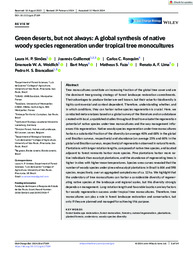Green deserts, but not always: a global synthesis of native woody species regeneration under tropical tree monocultures.
Green deserts, but not always: a global synthesis of native woody species regeneration under tropical tree monocultures.
Author(s): SIMÕES, L. H. P.; GUILLEMOT, J.; RONQUIM, C. C.; WEIDLICH, E. W. A.; MUYS, B.; FUZA, M. S.; LIMA, R. A.; BRANCALION, P. H. S.
Summary: Abstract: Tree monocultures constitute an increasing fraction of the global tree cover and are the dominant tree- growing strategy of forest landscape restoration commitments. Their advantages to produce timber are well known, but their value for biodiversity is highly controversial and context dependent. Therefore, understanding whether, and in which conditions, they can harbor native species regeneration is crucial. Here, we conducted meta-analyses based on a global survey of the literature and on a database created with local, unpublished studies throughout Brazil to evaluate the regeneration potential of native species under tree monocultures and the way management influ-ences this regeneration. Native woody species regeneration under tree monoculturesharbors a substantial fraction of the diversity (on average 40% and 68% in the global and Brazilian surveys, respectively) and abundance (on average 25% and 60% in the global and Brazilian surveys, respectively) of regeneration observed in natural forests. Plantations with longer rotation lengths, composed of native tree species, and located adjacent to forest remnants harbor more species. Pine plantations harbor more na-tive individuals than eucalypt plantations, and the abundance of regenerating trees is higher in sites with higher mean temperatures. Species–area curves revealed that the number of woody species under pine and eucalypt plantations in Brazil is 606 and 598 species, respectively, over an aggregated sampled area of ca. 12 ha. We highlight that the understory of tree monocultures can harbor a considerable diversity of regener-ating native species at the landscape and regional scales, but this diversity strongly depends on management. Long- rotation length and favorable location are key factors for woody regeneration success under tropical tree monocultures. Therefore, tree monocultures can play a role in forest landscape restoration and conservation, but only if they are planned and managed for achieving this purpose.
Publication year: 2024
Types of publication: Journal article
Unit: Embrapa Territorial
Observation
Some of Embrapa's publications are published as ePub files. To read them, use or download one of the following free software options to your computer or mobile device. Android: Google Play Books; IOS: iBooks; Windows and Linux: Calibre.
Access other publications
Access the Agricultural Research Database (BDPA) to consult Embrapa's full library collection and records.
Visit Embrapa Bookstore to purchase books and other publications sold by Embrapa.

